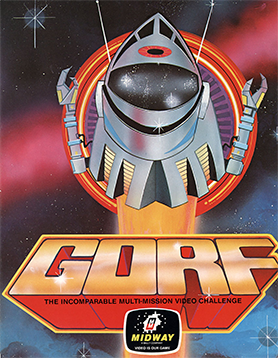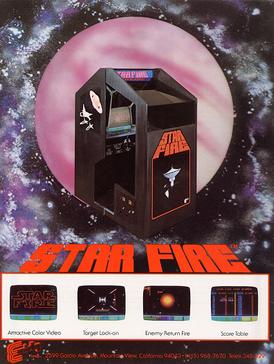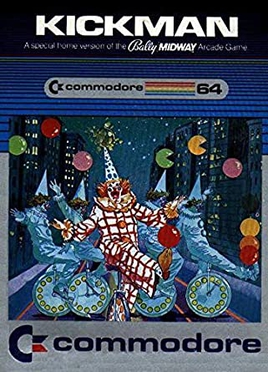
720° is a skateboarding video game released in arcades by Atari Games in 1986. The player controls a skateboarder skating around a middle-class neighborhood. By doing jumps and tricks, the player can eventually acquire enough points to compete at a skate park. The game's name comes from the "ultimate" trick, turning a full 720° in the air after jumping off a ramp.

Joust is an action game developed by Williams Electronics and released in arcades in 1982. While not the first two-player cooperative video game, Joust's success and polished implementation popularized the concept. Players assume the role of knights armed with lances and mounted on large birds, who must fly around the screen and defeat enemy knights riding buzzards.

Tapper, also known as Root Beer Tapper, is a 1984 arcade game developed by Marvin Glass and Associates and released by Bally Midway. Tapper puts the player in the shoes of a bartender who must serve eager, thirsty patrons while collecting empty mugs and tips. It was distributed in Japan by Sega in 1984.

Ms. Pac-Man is a 1982 maze arcade video game developed by General Computer Corporation and published by Midway. It is the first sequel to Pac-Man (1980) and the first entry in the series to not be made by Namco. Controlling the title character, Pac-Man's wife, the player is tasked with eating all of the pellets in an enclosed maze while avoiding four colored ghosts. Eating the larger "power pellets" lets the player eat the ghosts, who turn blue and flee.

Rampart is a 1990 video game released by Atari Games and Midway Games that combines the shoot 'em up, strategy, and puzzle genres. It debuted as an arcade game with trackball controls, and was ported to home systems. It had a limited US release in October 1990, and a wide release in early 1991. It was distributed in Japan by Namco.

Spy Hunter is a vehicular combat action game developed by Bally Midway and released for arcades in 1984. The game draws inspiration from the James Bond films and was originally supposed to carry the James Bond brand. The object of the game is to drive down roads in the technologically advanced "Interceptor" car and destroy various enemy vehicles with a variety of onboard weapons. Spy Hunter was produced in both sit-down and standard upright versions with the latter being more common. The game's controls consist of a steering wheel in the form of a futuristic aircraft-style yoke with several special-purpose buttons, a two-position stick shift, and a pedal used for acceleration.

Gorf is an arcade video game released in 1981 by Midway Manufacturing, whose name was advertised as an acronym for "Galactic Orbiting Robot Force". It is a fixed shooter with five distinct levels, the first of which is based on Space Invaders and another on Galaxian. The game makes heavy use of synthesized speech for the Gorfian robot which teases the player, powered by the Votrax speech chip. Gorf allows the player to buy two additional lives per quarter before starting the game, for a maximum of seven lives.

Robotron: 2084 is a multidirectional shooter developed by Eugene Jarvis and Larry DeMar of Vid Kidz and released in arcades by Williams Electronics in 1982. The game is set in the year 2084 in a fictional world where robots have turned against humans in a cybernetic revolt. The aim is to defeat endless waves of robots, rescue surviving humans, and earn as many points as possible.

1943: The Battle of Midway is a 1987 vertically scrolling shooter arcade video game developed and published by Capcom.

Pooyan (プーヤン) is a fixed shooter arcade video game released by Konami in Japan in 1982. It was manufactured in North America by Stern Electronics. The player controls "Mama", a pig whose babies have been kidnapped by a group of wolves.

Super Sprint is a racing video game released by Atari Games and Midway Games in 1986. Up to three players drive Formula One-like cars on a circuit that is viewed from above. The game is a successor to Gran Trak 10 and the Sprint series, which were black-and-white games from the 1970s. A sequel, Championship Sprint, was released later in the same year.

Paperboy is an arcade action game developed and published by Atari Games, and released in 1985. The player takes the role of a paperboy who delivers a fictional newspaper called The Daily Sun along a street on his bicycle. The arcade version of the game featured bike handlebars as the controller.

Moon Patrol is a 1982 arcade video game developed and released by Irem. It was licensed to Williams for distribution in North America. The player controls a Moon buggy which can jump over and shoot obstacles on a horizontally scrolling landscape as well as shoot aerial attackers. Designed by Takashi Nishiyama, Moon Patrol is often credited with the introduction of full parallax scrolling in side-scrolling games. Cabinet art for the Williams version was done by Larry Day. Most of the home ports were from Atari, Inc., sometimes under the Atarisoft label.

Night Driver is an arcade video game developed by Atari, Inc. and released in the United States in October 1976. It's one of the earliest first-person racing video games and is commonly believed to be one of the first published video games to feature real-time first-person graphics. Night Driver has a black and white display with the hood of the player's car painted on a plastic overlay. The road is rendered as scaled rectangles representing "pylons" that line the edges.

Star Fire is a first-person arcade coin-operated space combat video game created by Technical Magic for Midway-Bally and licensed for manufacture to Exidy in December 1978. It was distributed in Japan by Taito and Esco Trading in 1979. Designed by Caltech engineers Ted Michon, and David Rolfe and inspired by the movie Star Wars, the game is not based on a licensed property.

Kick is an action video game where the player controls a clown on a unicycle catching falling balloons and Pac-Man characters on the clown's hat. It was released in arcades by Midway in 1981. The game was later renamed Kick Man. Commodore published a Commodore 64 port in 1982 without the space in the title as Kickman.

Xybots is a 1987 third-person shooter arcade game by Atari Games. In Xybots, up to two players control "Major Rock Hardy" and "Captain Ace Gunn", who must travel through a 3D maze and fight against a series of robots known as the Xybots whose mission is to destroy all mankind. The game features a split screen display showing the gameplay on the bottom half of the screen and information on player status and the current level on the top half. Designed by Ed Logg, it was originally conceived as a sequel to his previous title, Gauntlet. The game was well received, with reviewers lauding the game's various features, particularly the cooperative multiplayer aspect. Despite this, it was met with limited financial success, which has been attributed to its unique control scheme that involves rotating the joystick to turn the player character.

Sea Wolf is an arcade video game designed by Dave Nutting and released by Midway in 1976. It is a video game update of an electro-mechanical Midway game, Sea Devil, itself based on Sega's 1966 electro-mechanical arcade submarine simulator Periscope. The game was released in Japan by Taito. In Sea Wolf, the player, piloting an unseen submarine, launches torpedoes vertically in an attempt to sink ships moving horizontally across the screen before time runs out. The screen is viewed through a faux periscope mounted on the cabinet.

Circus is a block breaker arcade game released by Exidy in 1977, and distributed by Taito in Japan. The game is a re-themed variant of Atari's Breakout, where the player controls a seesaw and clown in order to pop all the balloons in the level. The game has been copied and released under different names by numerous other companies in both the United States and Japan.

Speed Race is a 1974 arcade racing video game developed and manufactured by Taito and released under the titles Racer and Wheels in North America by distributor Midway Manufacturing in 1975. Designed by Tomohiro Nishikado, the gameplay involves the player using the attached steering wheel to maneuver a car alongside a fast vertical scrolling road. The objective is to score points by driving past other cars without colliding with them; more points are awarded for driving faster. Players must do this under a 90-second time limit, which ends the game when it runs out. The gameplay concepts were adapted from two earlier driving electro-mechanical games: Kasco's Mini Drive (1958) and Taito's Super Road 7 (1970).



















